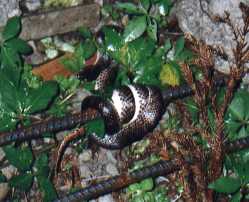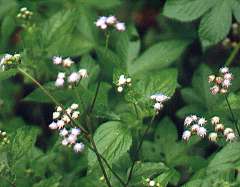![]()
Dangers
No matter where you are, there are bound to be some dangers and hazards to be aware of, especially in the wilderness. However, unlike guerrilla occupied tropical jungles full of aggressive mammals and poisonous snakes, there is little to be afraid of in Taiwan's forests. With a little common sense and a basic knowledge of possible threats, anyone can bird safely in Taiwan.
![]()
Mammals
I have rarely seen any large mammals while birding in Taiwan, much
less having been attacked by one. Mammals that have the potential to be
aggressive to humans include the Formosan rock-monkey (Formosan macaque),
Formosan/Asian Black Bear, Formosan wild boar (Formosan pig), and the Formosan
serow. Even these animals, however, except the monkey, are rarely seen
and usually try to flee when discovered. In some areas, monkeys have learned
to steal food from people and may become aggressive. However, just be cautious
and they should be quite harmless; they are much less of a problem than
the dogs kept by mountain inhabitants, which are often trained to attack
any unfamiliar being! Bears, though I have never seen one, are occasionally
encountered in the higher elevations and have been reported to attack humans,
especially if it is a female with cubs. The national park advises hikers
to make enough noise as not to surprise any wild animals. However, that
would not an ideal strategy if one was searching for the secretive Mikado
Pheasant! If one does stumble upon an animal that shows signs of aggression,
back out of its territory quietly and calmly, then turn and quickly get
out of the area.
 Snakes
Snakes
Just seeing a snake will send shivers down some peoples' spines. Snakes
are quite common in Taiwan, but usually one only gets a short glimpse of
a snake before it slithers deeper into the forest or into the grass. There
are only six poisonous species that are the dangerous. Even so, most of
these are docile and will not bite unless frightened. Rarely are people
ever bitten by snakes, and those incidences usually occur when someone
tries to capture and handle the snakes (people still eat snakes) or when
somebody accidentally steps on one. One should always try to avoid walking
through tall grasses and carry a flashlight when venturing outdoors at
night. If a snake is sighted, stand still and slowly back away. If ever
chased by a snake, which I find very hard to believe, run in a zig-zag
pattern. If ever bitten by a poisonous snake, stay calm. Keep the bitten
part below the heart, and don't move to prevent the venom from circulating
through the body. Most importantly, get treatment at a hospital as soon
as possible. There isn't much to fear about snakes, really. I have only
encountered live snakes less than a dozen times in more than five years
of birding, and none of those that I saw were poisonous. Snakes are fascinating
creatures, and I am always as excited to see a snake as when I see a new
bird (though I can't say the same for other parts of the world!).
Mosquitos and Ticks
Like most places, mosquitos are more of a nuisance than a real threat.
Mosquitos in Taiwan do not carry malaria, but those in the southern parts
of the island may carry dengue fever. Just take precautions and spray mosquito
repellent when birding in forests or marshes with a lot of mosquitos. Ticks
are usually not a problem either, though the ones on Orchid Island are
known to carry lime disease.
Wasps
 Besides
mosquitos carrying dengue fever, the only insects that take human lives
in Taiwan's forests are five aggressive species of Vespa wasps.
The danger comes when one does not notice a solitary wasp flying about
and finally runs into the territory of the entire colony. Avoid wearing
perfume or bright coloring, especially red, in the field. Once I was wearing
a shirt with a red collar and was nearly stung on the neck by the largest
wasp in Taiwan. Unlike honeybees, wasps do not have a barb at the end of
their stinger and do not die after they sting. If you ever see a nest or
notice agitated wasps or hornets circling you, get out of the area as quickly
as possible. If you must brush a wasp aside, do it gently; never try to
swat at wasps or hornets. If you are ever chased by an angry swarm, swing
your clothes at the swarm to try to confuse them while running in the opposite
direction. Wasps are not a great threat, scary as they may sound. Most
people attacked probably tried to swat at a wasp guarding its territory
or disturbed its nest somehow. A sting can be treated in the field with
urine or the sap of the wild taro plant that grows commonly in the forest.
Besides
mosquitos carrying dengue fever, the only insects that take human lives
in Taiwan's forests are five aggressive species of Vespa wasps.
The danger comes when one does not notice a solitary wasp flying about
and finally runs into the territory of the entire colony. Avoid wearing
perfume or bright coloring, especially red, in the field. Once I was wearing
a shirt with a red collar and was nearly stung on the neck by the largest
wasp in Taiwan. Unlike honeybees, wasps do not have a barb at the end of
their stinger and do not die after they sting. If you ever see a nest or
notice agitated wasps or hornets circling you, get out of the area as quickly
as possible. If you must brush a wasp aside, do it gently; never try to
swat at wasps or hornets. If you are ever chased by an angry swarm, swing
your clothes at the swarm to try to confuse them while running in the opposite
direction. Wasps are not a great threat, scary as they may sound. Most
people attacked probably tried to swat at a wasp guarding its territory
or disturbed its nest somehow. A sting can be treated in the field with
urine or the sap of the wild taro plant that grows commonly in the forest.
Leeches
Though nasty looking, leeches are harmless parasites. Their bite is
painless, and usually they've already finished their bloody meal by the
time one notices them. They cannot transmit diseases through their bites,
even though the wound could become infected if it is not cleaned and disinfected.
Fushan at Wulai, Taipei, is the only places where I have encountered leeches
in Taiwan, though I've heard that they are also common at Fushan Botanical
Garden, Ilan, and various other areas. And even at Fushan, I have only
seen them on rainy days. Leeches are black and can grow up to an inch long.
They often sit on vegetation or on the trails waiting for passing animals
to brush against them. I found that mosquito repellent containing DEET
works very effectively in repelling leeches.
 Stinging
Nettle
Stinging
Nettle
This plant is found in many parts of the world, so you may be quite
familiar with it already. It is a short plant that often grows on the sides
of trails. There are numerous sharp spines covering its leaves and stems,
and any contact with these spines will cause them to break off and inject
a painful toxin into the skin. The best precaution is to learn the appearance
of this plant and avoid brushing against it. Also avoid wearing shorts
when walking through narrow trails or areas where stinging nettle grows.
The sap of a purple or white flowering plant can help curb the pain caused
by contact with stinging nettles.
Falling Rocks & Landslides
 Much
of the mountainous regions in Taiwan consists of weak geographic structures,
and therefore tends to collapse whenever there is a lot of rain or earthquakes
(note that Taiwan also lies on the earthquake belt!). Taking precautions
is the best method. Whenever possible avoid traveling through mountainous
regions during the rainy season (typically between March and early June)
and when typhoons hit (usually in the summer). Landslides are very frequent
after consecutive days of rain. Remember that not only is getting into
an area a problem, getting out of it may also become a problem if a mudslide
occurs while you are inside a birding area! Usually the roads are fixed
within hours or days of the roadblock, but little-traveled roads or seriously
damaged roads may take even longer. While birding in rainy weather, avoid
overhanging cliffs, especially those with piles of fallen rocks below.
Don't linger too long where there are signs of fallen rocks or where the
hillside appears to be barren or unstable. One other thing to beware of
in rainy weather is lightening. In recent years lightening strikes have
claimed the lives of a number of hikers resting in pavilions during thunderstorms.
The safest place to be in a thunderstorm is in a car with the windows rolled
up.
Much
of the mountainous regions in Taiwan consists of weak geographic structures,
and therefore tends to collapse whenever there is a lot of rain or earthquakes
(note that Taiwan also lies on the earthquake belt!). Taking precautions
is the best method. Whenever possible avoid traveling through mountainous
regions during the rainy season (typically between March and early June)
and when typhoons hit (usually in the summer). Landslides are very frequent
after consecutive days of rain. Remember that not only is getting into
an area a problem, getting out of it may also become a problem if a mudslide
occurs while you are inside a birding area! Usually the roads are fixed
within hours or days of the roadblock, but little-traveled roads or seriously
damaged roads may take even longer. While birding in rainy weather, avoid
overhanging cliffs, especially those with piles of fallen rocks below.
Don't linger too long where there are signs of fallen rocks or where the
hillside appears to be barren or unstable. One other thing to beware of
in rainy weather is lightening. In recent years lightening strikes have
claimed the lives of a number of hikers resting in pavilions during thunderstorms.
The safest place to be in a thunderstorm is in a car with the windows rolled
up.
Traffic
 Although
many birding locations are accessible by public transportation, having
a car is still the most preferable means of getting to places. Driving
in Taipei or any other big city is probably not a good idea for someone
that comes from the countryside. Outside of the cities though, driving
is much less hellish. Beware, however, of aggressive drivers that one encounters
every now and then. The main danger from driving is in the mountains, where
meandering roads and fast driving just cannot mix. Falling rocks and landslides
occur frequently during typhoon or rainy seasons, especially in places
where the hillsides have been developed into orchards or betel nut plantations.
Fog, rain, or snow in the alpine regions are also frequent causes of traffic
accidents. One thing about birders, they tend to forget that they are driving
when a bird crosses their path. Keep your eyes on the road! Also, driving
is dangerous without sufficient rest, especially after a day of rigorous
hiking and birding.
Although
many birding locations are accessible by public transportation, having
a car is still the most preferable means of getting to places. Driving
in Taipei or any other big city is probably not a good idea for someone
that comes from the countryside. Outside of the cities though, driving
is much less hellish. Beware, however, of aggressive drivers that one encounters
every now and then. The main danger from driving is in the mountains, where
meandering roads and fast driving just cannot mix. Falling rocks and landslides
occur frequently during typhoon or rainy seasons, especially in places
where the hillsides have been developed into orchards or betel nut plantations.
Fog, rain, or snow in the alpine regions are also frequent causes of traffic
accidents. One thing about birders, they tend to forget that they are driving
when a bird crosses their path. Keep your eyes on the road! Also, driving
is dangerous without sufficient rest, especially after a day of rigorous
hiking and birding.